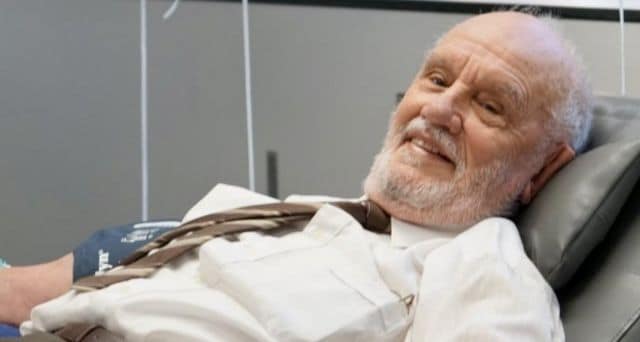He was known in Australia as the ‘man with a golden arm’.As per the Australian Red Cross Lifeblood, he helped in saving the lives of over 2.4 million Australian babies.James Harrison passed away in his sleep at a nursing home in New South Wales, Australia, on February 17, at the age of 88.ALSO READ |
Who is ‘India’s most generous’ man and how much did he donate?Over six decades, he donated plasma more than 1100 times and gained international recognition for his life-saving contributions.AdvertisementWho was he? How did his plasma donations help millions of babies?We will answer these questions.Who was James Harrison?Harrison was among the world’s most dedicated blood donors, with his plasma helping save over 2 million newborns.Known in Australia as the ‘man with the golden arm’, his blood contained a rare antibody, Anti-D, which was used to create a treatment for pregnant women whose blood could potentially harm their unborn children.Harrison passed away in his sleep at a nursing home in New South Wales. X/@goodnewsdogHe began donating plasma at 18 and continued every two weeks until he was 81.In 2005, he held the world record for the most blood plasma donations, a title he retained until 2022 when a donor from the US surpassed him, according to BBC.His journey as a donor started at 14 when he underwent major lung surgery. He required intensive care and multiple blood transfusions, which left him determined to give back.Despite his fear of needles, he kept his promise to donate as soon as he was eligible at 18. He was inspired by his father, who was a regular blood donor.In 1954, he made his first donation and continued visiting the Red Cross every fortnight for over 60 years, providing life-saving plasma until his retirement in 2018 at the age of 81. Notably, he never missed a single appointment, news.com.au reported.In recognition of his dedication, Harrison was awarded the Medal of the Order of Australia in 1999, one of the nation’s highest honours, for his service to the Australian Red Cross Lifeblood and the Anti-D programme.AdvertisementHis generosity leaves behind a “remarkable legacy, and he has put the challenge out to the Australian community to beat it,” Lifeblood said in a statement.What is Anti-D?Harrison’s plasma contained the rare and vital anti-D antibody.This antibody is used to produce medication that prevents haemolytic disease of the foetus and newborn (HDFN), a serious and potentially life-threatening condition where a pregnant woman’s immune system attacks her baby’s red blood cells.HDFN occurs when the mother’s blood type is incompatible with that of her unborn child. The mother’s immune system perceives the baby’s red blood cells as a threat and generates antibodies to destroy them. This can lead to severe anaemia, heart failure, or even death, according to BBC.AdvertisementBefore the introduction of anti-D treatment in the mid-1960s, half of the babies diagnosed with HDFN did not survive.Australia has fewer than 200 anti-D donors, yet their contributions support around 45,000 mothers and babies annually, according to Lifeblood.Harrison “expected nothing in return” for his generosity and continued to donate “even in his darkest days,” including after losing his wife Barbara, who was also a regular donor, Lifeblood chief executive Stephen Cornelissen said in a statement.AdvertisementHow did Harrison’s blood become rich in anti-D?The reason behind Harrison’s unusually high levels of anti-D and its lasting potency remains uncertain.However, it is likely linked to the extensive blood transfusion he underwent at the age of 14, The Sydney Morning Herald reported.Harrison estimated that he required 13 units (7.4 litres) of blood to survive a complex operation that removed most of his left lung. But he was never certain, as he was simply grateful to have made it through.A look at Harrison’s legacyHarrison made a total of 1,173 donations – 1,163 from his right arm and just 10 from his left. He never watched as the needle was inserted, according to The Sydney Morning Herald.Harrison’s daughter, Tracey Mellowship, fondly recalled him as a kind-hearted man with a great sense of humour.“James was a humanitarian at heart, but also very funny,” Mellowship was quoted as saying by The Independent.Advertisement“As an Anti-D recipient myself, he has left behind a family that may not have existed without his precious donations,” she said.Today, the number of Australian children who die from HDFN has dropped drastically, with the mortality rate falling over a hundred-fold to around 0.01 deaths per 1,000, which is roughly four babies per year.Harrison made a total of 1,173 donations. Australian Red Cross Lifeblood“Every batch of Anti-D that has ever been made in Australia has come from James’ blood,” Jemma Falkenmire of the Australian Red Cross Lifeblood told CNN in 2015.Researchers at WEHI (Walter and Eliza Hall Institute of Medical Research) in Melbourne, working alongside Lifeblood, have launched a project called “James in a Jar” to replicate the Anti-D antibody in a laboratory setting.By using blood and immune cells from Harrison and other donors, the team has successfully produced and grown the antibody, according to Lifeblood.This advancement could one day help prevent Haemolytic Disease of the Foetus and Newborn, providing crucial treatment for pregnant women not just in Australia, but around the world, the statement added.More from Health
Australia man whose blood saved 2 million babies dies: Who was James Harrison?
Does intense heat make people age faster?
How your breathing pattern has surprising impact on your pupil size
Does toothpaste kill good bacteria in your mouth?TagsAustraliaHealthEnd of Article
Link:
Australia man whose blood saved 2 million babies dies: Who was James Harrison?
